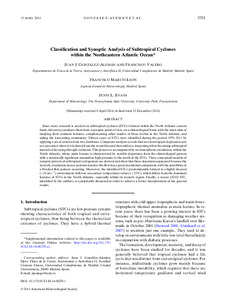Por favor, use este identificador para citar o enlazar este ítem:
http://hdl.handle.net/20.500.11765/1588
Classification and synoptic analysis of subtropical cyclones within the Northeastern Atlantic Ocean
Registro completo de metadatos
| Campo DC | Valor | Lengua/Idioma |
|---|---|---|
| dc.contributor.author | González-Alemán, Juan Jesús | es_ES |
| dc.contributor.author | Valero Rodríguez, Francisco | es_ES |
| dc.contributor.author | Martín León, Francisco | es_ES |
| dc.contributor.author | Evans, Jenni L. | es_ES |
| dc.date.accessioned | 2016-04-01T10:11:45Z | - |
| dc.date.available | 2016-04-01T10:11:45Z | - |
| dc.date.issued | 2015 | - |
| dc.identifier.citation | Journal de Climate. 2015, 28(8), p. 3331-3352 | es_ES |
| dc.identifier.issn | 0894-8755 | - |
| dc.identifier.issn | 1520-0442 | - |
| dc.identifier.uri | http://hdl.handle.net/20.500.11765/1588 | - |
| dc.description.abstract | Since more research is needed on subtropical cyclones (STCs) formed within the North Atlantic eastern basin, this survey analyzes them from a synoptic point of view, on a climatological basis, with the main aims of studying their common features, complementing other studies of these storms in the North Atlantic, and aiding the forecasting community. Fifteen cases of STCs were identified during the period 1979–2011 by applying a set of criteria from two databases. Composite analysis reveals that an extratropical depression acts as a precursor when it is isolated from the westerlies and then suffers a deepening when becoming subtropical instead of decaying through occlusion. This process is accompanied by an atmospheric circulation, within the North Atlantic, whose main feature is characterized by notable departures from the climatological pattern with a statistically significant anomalous high pressure to the north of the STCs. Three conceptual models of synoptic pattern of subtropical cyclogenesis are derived and show that these departures appeared because the westerly circulation moves poleward and/or the flow has a great meridional component, with the possibility of a blocked flow pattern occurring. Moreover, the identified STCs predominantly formed in a highly sheared (>10 m s−1) environment with low sea surface temperature values (<25°C), which differs from the dominant features of STCs in the North Atlantic, especially within its western region. Finally, a recent (2010) STC, identified by the authors, is synoptically discussed in order to achieve a better interpretation of the general results. | es_ES |
| dc.description.sponsorship | This work was supported under a MECD Grant (Spanish government), the MINECO projects CGL2011-25327 and PCIN-2014-013-C07-04 (Spanish government), and by the U.S. National Science Foundation under Grant ATM1322532. | - |
| dc.format | application/pdf | - |
| dc.language.iso | eng | es_ES |
| dc.publisher | American Meteorological Society | es_ES |
| dc.subject | Convection | es_ES |
| dc.subject | Wave breaking | es_ES |
| dc.subject | Cutoff lows | es_ES |
| dc.subject | Subtropical cyclones | es_ES |
| dc.subject | Extratropical cyclones | es_ES |
| dc.subject | Tropical cyclones | es_ES |
| dc.title | Classification and synoptic analysis of subtropical cyclones within the Northeastern Atlantic Ocean | es_ES |
| dc.type | info:eu-repo/semantics/article | es_ES |
| dc.relation.publisherversion | http://dx.doi.org/10.1175/JCLI-D-14-00276.1 | es_ES |
| dc.rights.accessRights | info:eu-repo/semantics/openAccess | es_ES |
| Colecciones: | Artículos científicos 2015-2018 | |
Ficheros en este ítem:
| Fichero | Descripción | Tamaño | Formato | ||
|---|---|---|---|---|---|
| 2015 GonzalezAleman-J... | 2,74 MB | Adobe PDF |  Visualizar/Abrir |
Los ítems de Arcimis están protegidos por una Licencia Creative Commons, salvo que se indique lo contrario.





